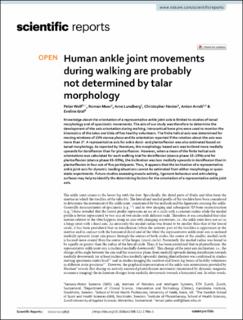Bitte benutzen Sie diese Kennung, um auf die Ressource zu verweisen:
https://doi.org/10.21256/zhaw-26562| Publikationstyp: | Beitrag in wissenschaftlicher Zeitschrift |
| Art der Begutachtung: | Peer review (Publikation) |
| Titel: | Human ankle joint movements during walking are probably not determined by talar morphology |
| Autor/-in: | Wolf, Peter Moor, Roman Lundberg, Arne Nester, Christopher Arndt, Anton Graf, Eveline |
| et. al: | No |
| DOI: | 10.1038/s41598-022-17984-5 10.21256/zhaw-26562 |
| Erschienen in: | Scientific Reports |
| Band(Heft): | 12 |
| Heft: | 1 |
| Seite(n): | 13856 |
| Erscheinungsdatum: | 16-Aug-2022 |
| Verlag / Hrsg. Institution: | Nature Publishing Group |
| ISSN: | 2045-2322 |
| Sprache: | Englisch |
| Schlagwörter: | Ankle; Biomechanical phenomenon; Human; Walking; Ankle joint; Talus |
| Fachgebiet (DDC): | 610: Medizin und Gesundheit |
| Zusammenfassung: | Knowledge about the orientation of a representative ankle joint axis is limited to studies of tarsal morphology and of quasistatic movements. The aim of our study was therefore to determine the development of the axis orientation during walking. Intracortical bone pins were used to monitor the kinematics of the talus and tibia of five healthy volunteers. The finite helical axis was determined for moving windows of 10% stance phase and its orientation reported if the rotation about the axis was more than 2°. A representative axis for ankle dorsi- and plantarflexion was also estimated based on tarsal morphology. As reported by literature, the morphology-based axis was inclined more medially upwards for dorsiflexion than for plantarflexion. However, when a mean of the finite helical axis orientations was calculated for each walking trial for dorsiflexion (stance phase 15-25%) and for plantarflexion (stance phase 85-95%), the inclination was less medially upwards in dorsiflexion than in plantarflexion in four out of five participants. Thus, it appears that the inclination of a representative ankle joint axis for dynamic loading situations cannot be estimated from either morphology or quasi-static experiments. Future studies assessing muscle activity, ligament behaviour and articulating surfaces may help to identify the determining factors for the orientation of a representative ankle joint axis. |
| URI: | https://digitalcollection.zhaw.ch/handle/11475/26562 |
| Volltext Version: | Publizierte Version |
| Lizenz (gemäss Verlagsvertrag): | CC BY 4.0: Namensnennung 4.0 International |
| Departement: | Gesundheit |
| Organisationseinheit: | Institut für Physiotherapie (IPT) |
| Enthalten in den Sammlungen: | Publikationen Gesundheit |
Dateien zu dieser Ressource:
| Datei | Beschreibung | Größe | Format | |
|---|---|---|---|---|
| 2022_Wolf-etal_Human-ankle-joint-movement-talar-morphology.pdf | 3.42 MB | Adobe PDF |  Öffnen/Anzeigen |
Zur Langanzeige
Wolf, P., Moor, R., Lundberg, A., Nester, C., Arndt, A., & Graf, E. (2022). Human ankle joint movements during walking are probably not determined by talar morphology. Scientific Reports, 12(1), 13856. https://doi.org/10.1038/s41598-022-17984-5
Wolf, P. et al. (2022) ‘Human ankle joint movements during walking are probably not determined by talar morphology’, Scientific Reports, 12(1), p. 13856. Available at: https://doi.org/10.1038/s41598-022-17984-5.
P. Wolf, R. Moor, A. Lundberg, C. Nester, A. Arndt, and E. Graf, “Human ankle joint movements during walking are probably not determined by talar morphology,” Scientific Reports, vol. 12, no. 1, p. 13856, Aug. 2022, doi: 10.1038/s41598-022-17984-5.
WOLF, Peter, Roman MOOR, Arne LUNDBERG, Christopher NESTER, Anton ARNDT und Eveline GRAF, 2022. Human ankle joint movements during walking are probably not determined by talar morphology. Scientific Reports. 16 August 2022. Bd. 12, Nr. 1, S. 13856. DOI 10.1038/s41598-022-17984-5
Wolf, Peter, Roman Moor, Arne Lundberg, Christopher Nester, Anton Arndt, and Eveline Graf. 2022. “Human Ankle Joint Movements during Walking Are Probably Not Determined by Talar Morphology.” Scientific Reports 12 (1): 13856. https://doi.org/10.1038/s41598-022-17984-5.
Wolf, Peter, et al. “Human Ankle Joint Movements during Walking Are Probably Not Determined by Talar Morphology.” Scientific Reports, vol. 12, no. 1, Aug. 2022, p. 13856, https://doi.org/10.1038/s41598-022-17984-5.
Alle Ressourcen in diesem Repository sind urheberrechtlich geschützt, soweit nicht anderweitig angezeigt.